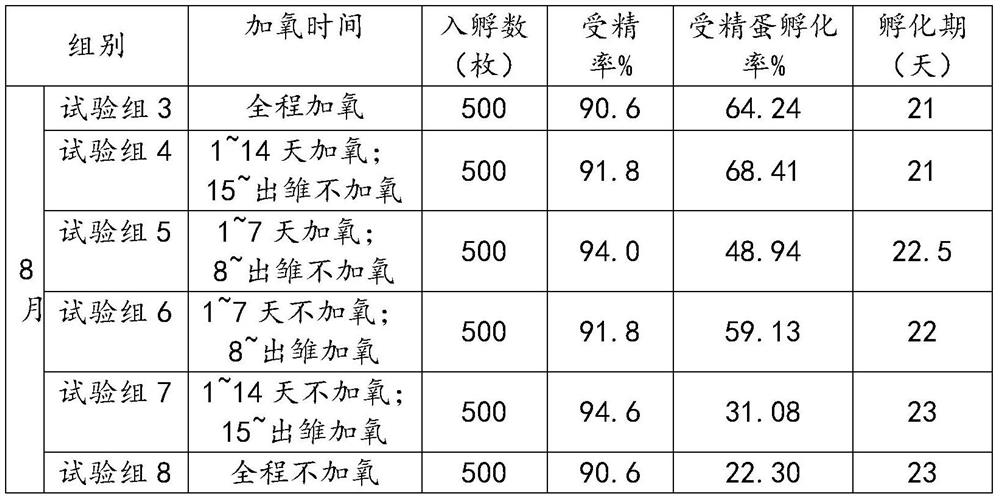A method for improving hatchability and chick viability of Tibetan chickens in high-altitude areas
A high-altitude, hatchability technology, applied in animal husbandry and other directions, can solve problems such as restricting animal husbandry production and economic development, having a greater impact on hatchability, and long hatching period, so as to improve the survival rate of chicks, improve the vitality of chicks, and improve the effect of Good results
- Summary
- Abstract
- Description
- Claims
- Application Information
AI Technical Summary
Problems solved by technology
Method used
Image
Examples
Embodiment 1
[0038] Embodiment 1 Whole process of adding oxygen and the hatching contrast experiment of whole process not adding oxygen
[0039] In Nimu County, Tibet, at an altitude of 3,950 meters, the Tibetan Chicken Breeding Farm of Beijing Deqingyuan Agricultural Science and Technology Co., Ltd.’s Tibet Experimental Base conducts oxygenation incubation experiments. All Tibetan chickens are artificially inseminated and Eai brand incubators are used. The normal state in the incubator The oxygen concentration is 19-20%, and the oxygen partial pressure is about 12.9kPa. The test time was November, and they were divided into two test groups. The test group 1 added oxygen throughout the incubation period, the oxygen concentration was maintained at 30-35%, and the oxygen partial pressure was about 20kPa. The test group 2 did not add oxygen throughout the incubation period and maintained a normal oxygen concentration. The specific operation steps are as follows:
[0040] 1) Collect artificia...
Embodiment 2
[0051] Embodiment 2 Vitality Feeding Experiment of Oxygenated Hatched Chicks
[0052] In Nimu County, Tibet, the altitude is 3950 meters, and the normal oxygen concentration is 19-20%. The Tibetan Chicken Breeding Farm of Tibet Experimental Base of Beijing Deqingyuan Agricultural Science and Technology Co., Ltd. carries out the vitality feeding experiment of oxygenated hatchling chicks, using the embodiment 1. The chicks obtained are raised according to the conventional feeding mode, and the dead rate of 1-6 weeks is counted, and the results are as follows:
[0053] Table 2 Viability Feeding Experiment of Tibetan Chicken Chicks Hatch with Oxygen and No Oxygen
[0054]
[0055] The above results show that the viability of the Tibetan chicken chicks was significantly improved in the experimental group that added oxygen throughout the hatching, which was more than 5 times higher than that in the experimental group without oxygen, and the death rate in the brooding stage was si...
Embodiment 3
[0056] Embodiment 3 The incubation comparative test of adding oxygen in stages
[0057] In Nimu County, Tibet, at an altitude of 3,950 meters, the Tibet Experimental Base of Beijing Deqingyuan Agricultural Science and Technology Co., Ltd. carried out a staged oxygenation incubation experiment for Tibetan chickens. All Tibetan chickens were artificially inseminated and Eai brand incubators were used. The normal oxygen concentration is 19-20%, the oxygen partial pressure is about 12.9kPa, the test time is August, and it is divided into 6 test groups (test group 3-8), test group 3 adds oxygen throughout the incubation period, test group 4 hatches Oxygen was added during the 1-14 days of the incubation period, test group 5 was added with oxygen during the incubation period of 1-7 days, test group 6 was added with oxygen during the incubation period of 8-21 days, test group 7 was added with oxygen during the incubation period of 15-21 days, and test group 8 was added during the enti...
PUM
 Login to View More
Login to View More Abstract
Description
Claims
Application Information
 Login to View More
Login to View More - R&D
- Intellectual Property
- Life Sciences
- Materials
- Tech Scout
- Unparalleled Data Quality
- Higher Quality Content
- 60% Fewer Hallucinations
Browse by: Latest US Patents, China's latest patents, Technical Efficacy Thesaurus, Application Domain, Technology Topic, Popular Technical Reports.
© 2025 PatSnap. All rights reserved.Legal|Privacy policy|Modern Slavery Act Transparency Statement|Sitemap|About US| Contact US: help@patsnap.com



